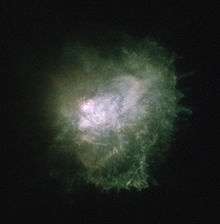VY Canis Majoris
VY Canis Majoris (abbreviated to VY CMa) is an extreme oxygen-rich (O-rich) red hypergiant (RHG) or red supergiant (RSG) and pulsating variable star located at 1.2 kiloparsecs (3,900 ly) away from Earth in the constellation of Canis Major. It is one of the largest known stars by radius, and is also one of the most luminous and massive red supergiants, as well as one of the most luminous stars in the Milky Way.
VY CMa is a single star with a large infrared (IR) excess, making it one of the brightest objects in the sky at wavelengths of between 5 and 20 microns (µm) and indicating a dust shell or disk heated by the star.[14][15] It is about 17±8 times the mass of the Sun (M☉). It is also surrounded by a complex asymmetric circumstellar envelope (CSE) caused by mass loss from the star itself. It produces strong molecular maser emission and was one of the first radio masers discovered. VY CMa is embedded within the large molecular cloud Sh2-310, one of the largest star-forming H II regions with a diameter of 480 arcminutes (') or 681 ly (209 pc).[16][17]
The radius of VY CMa is about 1,420 times that of the Sun (R☉), which is close to the Hayashi limit and corresponds to a volume about 3 billion times bigger than the Sun. A hypothetical object travelling at the speed of light would take 6 hours to travel around the star's circumference, compared to 14.5 seconds for the Sun.[18] If placed at the center of the Solar System, VY CMa's surface would extend beyond the orbit of Jupiter, although there is still considerable variation in estimates of the radius, with some making it larger than the orbit of Saturn.[4]
Observational history

The first known recorded observation of VY Canis Majoris is in the star catalogue of the French astronomer Jérôme Lalande, on 7 March 1801, which lists it as a 7th magnitude star. Further 19th- and 20th-century studies of its apparent magnitude suggested that the star had been fading since 1850.[19]
Since 1847, VY Canis Majoris has been described as a crimson star.[19] During the 19th century, observers measured at least six discrete components, suggesting that it might be a multiple star. These discrete components are now known to be bright areas in the surrounding nebula. Visual observations in 1957 and high-resolution imaging in 1998 showed that there are no companion stars.[19][20] VY CMa was also discovered to be a strong source of OH (1612 MHz), H
2O (22235.08 MHz), and SiO (43122 MHz) masers emission, which is typical of an OH/IR star.[21][22][23] Many molecules, such as HCN, NaCl, PN, CH, CO, CH
3OH, TiO, and TiO
2, have also been detected.[24][25][3][26][27]
The variation in VY CMa's brightness was first described in 1931 when it was listed (in German) as a long-period variable with a photographic magnitude range of 9.5 to 11.5.[28] It was given the variable star designation VY Canis Majoris in 1939, the 43rd variable star of the constellation Canis Major.[29]
Surroundings
VY Canis Majoris is surrounded by an extensive and dense asymmetric red reflection nebula with a total ejected mass of 0.2-0.4 M☉ and a temperature of 800 K based on a DUSTY model atmosphere that has been formed by material expelled from its central star.[14][30] The diameter of the inner shell is found to be 0".12, corresponding to 140 AU (0.0022 ly) at a distance of 1.2 kpc, whereas that of the outer one is 10", corresponding to 12,000 AU (0.19 ly).[30] This nebula is so bright that it was discovered in 1917 with an 18 cm telescope, and also contains condensations that were once regarded as companion stars.[20] It has been extensively studied with the aid of the Hubble Space Telescope (HST), showing that the nebula has a complex structure that includes filaments and arcs, which were caused by past eruptions; this structure is similar to that of the nebula surrounding the post-red supergiant (Post-RSG) or yellow hypergiant (YHG) IRC +10420. The similarity has led astronomers to propose that VY CMa will evolve blueward on the Hertzsprung–Russell diagram (HR diagram) to become a yellow hypergiant, then a Luminous blue variable (LBV), and finally a Wolf–Rayet star (WR star).[20][14]

Observations combining Hubble Space Telescope data with that obtained from the Keck Telescope, located in Hawaii, it was possible to make a three-dimensional reconstruction of the material surrounding VY CMa. This reconstruction showed that VY CMa's mass loss is much more complex than expected for any red supergiant or hypergiant. It became clear that the bows and nodules appeared at different times; the jets are randomly oriented, which leads us to believe that they derive from explosions occurred in active regions of the stellar photosphere. The spectroscopic data showed that the jets move away from the star at different speeds, indicating that they occurred at different times and originate from different areas of the surface of VY CMa.[31] Multiple asymmetric mass loss events and also the ejection of the outermost material are deduced to have occurred within the last 500–1,000 years, while that of a knot near the star would be less than 100 years. The mass loss is due to strong convection in the tenuous outer layers of the star, associated with magnetic fields. This is similar to the sunspots and coronal ejections of the Sun but on a much larger scale.[10][32][31]
Distance
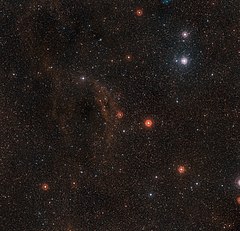
(ESO/Digitized Sky Survey 2)

In 1976, Charles J. Lada and Mark J. Reid published observations of the bright-rimmed molecular cloud Sh2-310, which is 15' east of VY Canis Majoris. At the edge of the cloud bordered by the bright rim, an abrupt decrease in the CO emission and an increase in brightness of the 12
CO emission were observed, indicating possible destruction of molecular material and enhanced heating at the cloud-rim interface, respectively. Lada and Reid assumed the distance of Sh2-310 is approximately equal to that of the stars, which are members of the open cluster NGC 2362, that ionize the rim. NGC 2362 has a distance of 1.5±0.5 kiloparsecs (kpc) or roughly 4,890±1,630 light-years (ly) as determined from its color-magnitude diagram.[33] VY CMa is projected onto the tip of the cloud rim, suggesting its association with Sh2-310. In addition to that, the velocity of Sh2-310 is very close to the velocity of the star. This further indicates the association of the star with Sh2-310, and consequently with NGC 2362, which means VY Canis Majoris is at the same distance.[34] A more recent measurement of the distance to NGC 2362 gives 1.2 kpc or about 3,910 ly.[35]
Stellar distances can be calculated by measuring parallaxes as Earth orbits around the Sun. However, VY Canis Majoris has a small parallax due to its great distance, and standard visual observations have a margin of error too large for a hypergiant star with an extended CSE to be useful, for example, the Hipparcos Catalogue (1997) gives a parallax of 1.78±3.54 milliarcseconds (mas), yielding a distance of 561.8 pc (1,832.34 ly).[36] The parallax of VY CMa can be precisely measured with high accuracy from the observation of masers using a long baseline interferometry. In 2008, observations of H
2O masers using VERA interferometry from the National Astronomical Observatory of Japan give a parallax of 0.88±0.08 mas, corresponding to a distance of 1.14+0.11
−0.09 kpc (about 3,720+360
−300 ly).[37] In 2012, observations of SiO masers using Very-long-baseline interferometry (VLBI) from Very Long Baseline Array (VLBA) independently derived a parallax of 0.83±0.08 mas, corresponding to a distance of 1.20+0.13
−0.10 kpc (about 3,910+423
−326 ly).[11] These new distance estimates imply that either Sh2-310 is less remote than usually estimated or that VY CMa is a foreground object.[16]
The Gaia mission should provide visual parallaxes with sufficient accuracy to constrain the distance to VY CMa, but the data release 2 value of −5.92±0.83 mas is not meaningful.[38]
Variability
VY Canis Majoris is a variable star that varies from an apparent visual magnitude of 9.6 at minimum brightness to a magnitude of 6.5 at maximum brightness with an estimated pulsational period of 956 days.[2][9] In the General Catalogue of Variable Stars (GCVS) it is classed a semiregular variable of sub-type SRc, indicating a cool supergiant,[2] although it is classed as a type LC slow irregular variable star in the American Association of Variable Star Observers (AAVSO) Variable Star Index.[9] Other periods of 1,600[39] and 2,200[20] days have been derived.
VY CMa is sometimes considered as the prototype for a class of heavily mass-losing OH/IR supergiants, distinct from the more common asymptotic giant branch OH/IR stars.[40]
Spectrum
The spectrum of VY Canis Majoris is that of a high luminosity M class star. The hydrogen lines, however, have P Cygni profiles fit for luminous blue variables. The spectrum is dominated by TiO bands whose strengths suggest a classification of M5. The H-alpha (Hα) line is not visible yet and there are unusual emission lines of neutral elements such as sodium and calcium. The luminosity class as determined from different spectral features varies from bright giant (II) to bright supergiant (Ia), with a compromise being given as M5eIbp. Early attempts at classification were confused by the interpretation of surrounding nebulosity as companion stars.[41]
The derived spectral class varies depending on the features examined. The spectral features also vary noticeably over time. It is considered to be unambiguously cooler, and thus redder, than M2, and is usually classified between M3 and M5. Classes as extreme as M2.5 and M5 have been given.[4] The luminosity class is likewise confused and often given only as I, partly because luminosity classes are poorly defined in the red and infrared portions of the spectrum. One study though, gives a luminosity class of Ia+ which means a hypergiant or extremely luminous supergiant.[42]
Physical properties
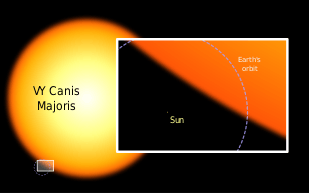

1. Mercury < Mars < Venus < Earth
2. Earth < Neptune < Uranus < Saturn < Jupiter
3. Jupiter < Proxima Centauri < Sun < Sirius
4. Sirius < Pollux < Arcturus < Aldebaran
5. Aldebaran < Rigel < Antares < Betelgeuse
6. Betelgeuse < Mu Cephei < VV Cephei A < VY Canis Majoris.
A very large and luminous star, VY CMa is among the most extreme stars in the Milky Way and has an effective temperature below 4,000 K (3,730 °C; 6,740 °F). It occupies the upper-right hand corner of the HR diagram although its exact luminosity and temperature are uncertain. Most of the properties of the star depend directly on its distance.
Luminosity
The bolometric luminosity (Lbol) of VY CMa can be calculated from Spectral energy distribution (SED) or bolometric flux, which can be determined from photometry in several visible and infrared bands. Earlier calculations of the luminosity based on an assumed distance of 1.5 kpc gave luminosities between 200,000 and 560,000 times the Sun's luminosity (L☉).[14][43][33] This is considerably very close or beyond the empirical Humphreys–Davidson limit. One study gave nearly one million L☉ at a distance of 2.1 kpc (6,800 ly).[44] In 2006 a luminosity of 430,000 L☉ was calculated by integrating the total fluxes over the entire nebula, since most of the radiation coming from the star is reprocessed by the dust in the surrounding cloud.[32] More recent estimates of the luminosity derive values below 350,000 L☉ based on distances below 1.2 kpc.[3][37][45]
Most of the output of VY CMa is emitted as infrared radiation, with a maximum emission at 5–10 μm, which is in part caused by reprocessing of the radiation by the circumstellar nebula.[32][10] Many older luminosity estimates are consistent with current ones if they are re-scaled to the distance of 1.2 kpc.[37] Despite being one of the most luminous stars in the Milky Way, much of the visible light of VY CMa is absorbed by the circumstellar envelope, so it cannot be seen with the naked eye and needs a telescope to be observed. It would be a naked eye star if no light was absorbed.[24]
Mass
Since VY CMa has no companion star, its mass cannot be measured directly through gravitational interactions. Comparison of the effective temperature and bolometric luminosity of VY CMa compared to evolutionary tracks for massive stars suggest an initial mass of 25±10 M☉ for a rotating star with a current mass of 15 M☉, or 32 M☉ for a non-rotating star with a current mass of 19 M☉,[3] and an age of 8.2 million years (MYr).[11] Older studies have found much higher initial masses (thus also higher current masses) or a progenitor mass of 40–60 M☉ based on old luminosity estimates.[14][46]
Mass loss

VY CMa has a strong stellar wind and is losing a lot of material due to its high luminosity and relatively low surface gravity. It has an average mass loss rate of 6×10−4 M☉ per year, among the highest known and unusually high even for a red supergiant, as evidenced by the extensive circumstellar envelope.[39][30] It is consequently one of the most important stars for understanding the high-mass loss episodes near the end of massive star evolution.[47] The mass loss rate probably exceeded 10−3 M☉/yr during the most violent mass loss events.[30]
Temperature
The effective temperature of VY CMa is uncertain but as the spectrum of VY CMa varies, then also the temperature may vary. Early estimates of the temperature of VY CMa assumed values below 3,000 K based on a spectral class of M5.[43][44] In 2006, its temperature was calculated to be as high as 3,650±25 K, corresponding to a spectral class of M2.5,[4] although VY CMa is usually considered as an M4-M5 star. Adopting the spectral class of M4-M5 with the temperature scale proposed by Emily Levesque gives a range of between 3,450 and 3,535 K.[48]
Size
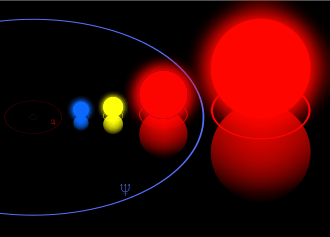
The calculation of the radius of VY CMa is complicated by the extensive circumstellar envelope of the star. VY CMa is also a pulsating star, so its size changes with time. Earlier direct measurements of the radius at infrared (K-band = 2.2 µm) wavelength gave an angular diameter of 18.7±0.5 mas, corresponding to radii above 3,000 R☉ (2.1×109 km; 14 au; 1.3×109 mi) at an assumed distance of 1.5 kpc, considerably larger than expected for any red supergiant or red hypergiant.[43] However, this is probably larger than the actual size of the underlying star and the angular diameter estimate appears exceedingly large due to interference by the circumstellar envelope.[32][10][3] In 2006–2007 radii of 1,800–2,100 R☉ have been derived from the estimated luminosity of 430,000 L☉ and temperatures of 3,200–3,535 K.[32][10]
On 6 and 7 March 2011, VY CMa was observed at near-infrared wavelengths using interferometry at the Very Large Telescope. The size of the star was calculated using the Rosseland Radius, the location at which the optical depth is 2⁄3,[49] with two modern distances of 1.14+0.11
−0.09 and 1.20+0.13
−0.10 kpc.[37][11] Its angular diameter was directly measured at 11.3±0.3 mas, which corresponds to a radius of 1,420±120 R☉ at a distance of 1.17+0.08
−0.07 kpc. The high spectral resolution of these observations allowed the effects of contamination by circumstellar layers to be minimised. An effective temperature of 3,490±90 K, corresponding to a spectral class of M4, was then derived from the radius and a luminosity of 270,000±40,000 L☉ which is based on the distance and a measured flux of (6.3±0.3)×10−13 W/cm2.[3]
Most radius estimates of the VY CMa are considered as the size for the optical photosphere while the size of the star for the radio photosphere is calculated to be twice that of the size of the star for the optical photosphere.[5] Despite the mass and very large size (though some estimates give smaller sizes), VY CMa has an average density of 5.33 to 8.38 mg/m3 (0.00000533 to 0.00000838 kg/m3), it is over 100,000 times less dense than Earth's atmosphere at sea level (1.2 kg/m3).
Largest star
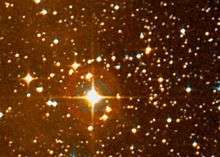
(Rutherfurd Observatory/Columbia University)
VY Canis Majoris has been known to be an extreme object since the middle of the 20th century, although its true nature was uncertain.[41][50] In the late 20th century, it was accepted that it was a post-main sequence red supergiant. Its angular diameter had been measured and found to be significantly different depending on the observed wavelength. The first meaningful estimates of its properties showed a very large star, well in excess of a thousand R☉.[51][52]
In contrast to prevailing opinion, a 2006 study, ignoring the effects of the circumstellar envelope in the observed flux of the star, derived a luminosity of 60,000 L☉, suggesting an initial mass of 15 M☉ and radius of 600 R☉ based on an assumed effective temperature of 3,650 K and distance of 1.5 kpc. On this basis they considered VY CMa and another notable extreme cool hypergiant star, NML Cygni, as normal early-type red supergiants.[4][53] They assert that earlier very high luminosities of 500,000 L☉ and very large radii of 2,800–3,230 R☉[14][54] (or even 4,000 R☉[20]) were based on effective temperatures below 3,000 K that were unreasonably low.[4]
Almost immediately another paper published a size estimate of 1,800–2,100 R☉ and concluded that VY CMa is a true hypergiant. This was based on the most recent temperature calibrations, giving an effective temperature of 3,450–3,535 K, and a luminosity of 430,000 L☉ based on SED integration and a distance of 1.5 kpc.[32]
Since then, the size of VY CMa has been calculated more accurately to be somewhat lower, for example 1,420 R☉,[3] while larger sizes have been published for a number of other galactic and extragalactic red supergiants (and hypergiants) such as Westerlund 1-26, WOH G64, and Stephenson 2-18. Despite this, VY Canis Majoris is still often described as the largest known star, sometimes with caveats to account for the highly uncertain sizes of all these stars.[55][lower-alpha 1] Another recent estimate based on the Wittkowski radius and the Monnier radius derived an average size of 2,000 R☉.[27]
Evolution
VY Canis Majoris is a highly evolved star with an age less than 10 Myr although some older authors argued that it would rather either be a very young protostar or a massive pre-main-sequence star with an age of only 1 MYr and also a circumstellar disk around the star.[15] It has probably evolved from an O9 main sequence star with a radius of 5 - 20 R☉.[33][56][31] The star has evolved rapidly because of its high mass. The time spent to the red hypergiant phase is estimated to be between 100,000 and 500,000 years, and thus VY CMa had left its main sequence more than a million years ago.[11][31]
The future evolution of VY CMa is uncertain, but like the most cool supergiants, the star will certainly explode as a supernova. It has begun to fuse helium into carbon, whereas a main sequence star fuses hydrogen into helium. Like Betelgeuse, it is losing mass at a high rate as it uses up its nuclear fuel, and is expected to explode as a supernova within the next 100,000 years, although it will probably evolve to a higher temperature beforehand.[57][3][55] VY CMa has been discovered to be very unstable, having a prodigious mass loss rate. In this case, the CO emission is coincident with the bright KI shell in its asymmetric nebula. VY CMa will produce a moderately luminous and long-lasting type IIn supernova (SN IIn), or even a hypernova or superluminous supernova (SLSN) comparable to SN 1988Z (or possibly a type Ib supernova), but it is unlikely that the supernova would be extremely luminous like SN 2006tf or SN 2006gy. The explosion could be associated with gamma-ray bursts (GRB) and it will also produce a shock wave of a speed of a few thousand kilometers per second that could hit the surrounding envelope of material, causing strong emission for many years after the explosion. For a star as massive as VY CMa, the remnant would be probably a black hole rather than a neutron star.[57]
Notes
- Alcolea et al 2013 refer to VY CMa as having the highest radius "among well-characterised stars in our galaxy", referring to the Wittkowski et al. 2012 value of 1,420 R☉ which is based on the distances from Choi et al. 2008 and Zhang et al. 2012 plus an angular diameter. Several red supergiants (or hypergiants) are possibly larger, although they could have less accurate radius estimates.
References
- Van Leeuwen, F. (2007). "Validation of the new Hipparcos reduction". Astronomy and Astrophysics. 474 (2): 653–664. arXiv:0708.1752. Bibcode:2007A&A...474..653V. doi:10.1051/0004-6361:20078357.
- "GCVS Query=VY CMa". General Catalogue of Variable Stars @ Sternberg Astronomical Institute, Moscow, Russia. Retrieved 24 November 2010.
- Wittkowski, M.; Hauschildt, P.H.; Arroyo-Torres, B.; Marcaide, J.M. (5 April 2012). "Fundamental properties and atmospheric structure of the red supergiant VY CMa based on VLTI/AMBER spectro-interferometry". Astronomy & Astrophysics. 540: L12. arXiv:1203.5194. Bibcode:2012A&A...540L..12W. doi:10.1051/0004-6361/201219126.
- Massey, Philip; Levesque, Emily M.; Plez, Bertrand (1 August 2006). "Bringing VY Canis Majoris down to size: an improved determination of its effective temperature". The Astrophysical Journal. 646 (2): 1203–1208. arXiv:astro-ph/0604253. Bibcode:2006ApJ...646.1203M. doi:10.1086/505025.
- Lipscy, S. J.; Jura, M.; Reid, M. J. (10 June 2005). "Radio photosphere and mass-loss envelope of VY Canis Majoris". The Astrophysical Journal. 626 (1): 439–445. arXiv:astro-ph/0502586. Bibcode:2005ApJ...626..439L. doi:10.1086/429900.
- Ducati, J. R (2002). "VizieR Online Data Catalog: Catalogue of Stellar Photometry in Johnson's 11-color system". VizieR On-line Data Catalog. Bibcode:2002yCat.2237....0D.
- De Beck, E.; Decin, L.; De Koter, A.; Justtanont, K.; Verhoelst, T.; Kemper, F.; Menten, K. M. (2010). "Probing the mass-loss history of AGB and red supergiant stars from CO rotational line profiles. II. CO line survey of evolved stars: Derivation of mass-loss rate formulae". Astronomy and Astrophysics. 523: A18. arXiv:1008.1083. Bibcode:2010A&A...523A..18D. doi:10.1051/0004-6361/200913771.
- Serkowski, K (1969). "Large Optical Polarization of the OH Emission Source VY Canis Majoris". The Astrophysical Journal. 156: L139. Bibcode:1969ApJ...156L.139S. doi:10.1086/180366.
- "VSX: Detail for VY CMa". American Association of Variable Star Observers. Retrieved 20 July 2018.
- Humphreys, Roberta M.; Helton, L. Andrew; Jones, Terry J. (2007). "The Three-Dimensional Morphology of VY Canis Majoris. I. The Kinematics of the Ejecta". The Astronomical Journal. 133 (6): 2716–2729. arXiv:astro-ph/0702717. Bibcode:2007AJ....133.2716H. doi:10.1086/517609.
- Zhang, B.; Reid, M. J.; Menten, K. M.; Zheng, X. W. (January 2012). "Distance and Kinematics of the Red Hypergiant VY CMa: VLBA and VLA Astrometry". The Astrophysical Journal. 744 (1): 23. arXiv:1109.3036. Bibcode:2012ApJ...744...23Z. doi:10.1088/0004-637X/744/1/23.
- Davies, Ben; Beasor, Emma R. (March 2020). "The `red supergiant problem': the upper luminosity boundary of Type II supernova progenitors". MNRAS. 493 (1): 468–476. arXiv:2001.06020. Bibcode:2020MNRAS.493..468D. doi:10.1093/mnras/staa174.
- Matsuura, Mikako; Sargent, B; Swinyard, Bruce; Yates, Jeremy; Royer, P; Barlow, M. J; Boyer, Martha; Decin, L; Khouri, Theo; Meixner, Margaret; van Loon, Jacco Th; Woods, Paul M (2016). "The mass-loss rates of red supergiants at low metallicity: Detection of rotational CO emission from two red supergiants in the Large Magellanic Cloud". Monthly Notices of the Royal Astronomical Society. 462 (3): 2995–3005. arXiv:1608.01729. Bibcode:2016MNRAS.462.2995M. doi:10.1093/mnras/stw1853.
- Smith, Nathan; Humphreys, Roberta M.; Davidson, Kriz; Gehrz, Robert D.; Schuster, M. T.; Krautter, Joachim (February 2001). "The Asymmetric Nebula Surrounding the Extreme Red Supergiant Vy Canis Majoris". The Astronomical Journal. 121 (2): 1111–1125. Bibcode:2001AJ....121.1111S. doi:10.1086/318748.
- Herbig, G. H (1970). "VY Canis Majoris. II. Interpretation of the Energy Distribution". The Astrophysical Journal. 162: 557. Bibcode:1970ApJ...162..557H. doi:10.1086/150688.
- "Result for Sh-2 310". Galaxy Map. Retrieved 20 August 2018.
- Sharpless, Stewart (1959). "A Catalogue of H II Regions". The Astrophysical Journal Supplement Series. 4: 257. Bibcode:1959ApJS....4..257S. doi:10.1086/190049.
- "Solar System Exploration: Planets: Sun: Facts & Figures". NASA. Archived from the original on 2 January 2008. Retrieved 15 January 2016.
- Robinson, L. J. (1971). "Three Somewhat Overlooked Facets of VY Canis Majoris". Information Bulletin on Variable Stars. 599: 1. Bibcode:1971IBVS..599....1R.
- Wittkowski, M.; Langer, N.; Weigelt, G. (2004). "Diffraction-limited speckle-masking interferometry of the red supergiant VY CMa". Astronomy and Astrophysics. 340 (2004): 77–87. arXiv:astro-ph/9811280. Bibcode:1998A&A...340L..39W.
- Wilson, William J; Barrett, Alan H (1968). "Discovery of Hydroxyl Radio Emission from Infrared Stars". Science. 161 (3843): 778–9. Bibcode:1968Sci...161..778W. doi:10.1126/science.161.3843.778. PMID 17802620.
- Eliasson, B; Bartlett, J. F (1969). "Discovery of an Intense OH Emission Source". The Astrophysical Journal. 155: L79. Bibcode:1969ApJ...155L..79E. doi:10.1086/180306.
- Snyder, L. E; Buhl, D (1975). "Detection of new stellar sources of vibrationally excited silicon monoxide maser emission at 6.95 millimeters". The Astrophysical Journal. 197: 329. Bibcode:1975ApJ...197..329S. doi:10.1086/153517.
- David Darling. "VY Canis Majoris". Retrieved 9 July 2018.
- "VY Canis Majoris". American Association of Variable Star Observers. 13 April 2010.
- De Beck, E; Vlemmings, W; Muller, S; Black, J. H; O'Gorman, E; Richards, A. M. S; Baudry, A; Maercker, M; Decin, L; Humphreys, E. M (2015). "ALMA observations of TiO2 around VY Canis Majoris". Astronomy and Astrophysics. 580: A36. arXiv:1506.00818. Bibcode:2015A&A...580A..36D. doi:10.1051/0004-6361/201525990.
- Kamiński, T; Gottlieb, C. A; Menten, K. M; Patel, N. A; Young, K. H; Brünken, S; Müller, H. S. P; McCarthy, M. C; Winters, J. M; Decin, L (2013). "Pure rotational spectra of TiO and TiO2 in VY Canis Majoris". Astronomy and Astrophysics. 551 (2013): A113. arXiv:1301.4344. Bibcode:2013A&A...551A.113K. doi:10.1051/0004-6361/201220290.
- Hoffmeister, Cuno (1931). "316 neue Veränderlilche". Astronomische Nachrichten. 242 (7): 129–142. Bibcode:1931AN....242..129H. doi:10.1002/asna.19312420702.
- Guthnick, P.; Schneller, H. (1939). "Benennung von veränderlichen Sternen". Astronomische Nachrichten. 268 (11–12): 165. Bibcode:1939AN....268..165G. doi:10.1002/asna.19392681102.
- Shenoy, Dinesh; Humphreys, Roberta M; Terry Jay Jones; Marengo, Massimo; Gehrz, Robert D; Andrew Helton, L; Hoffmann, William F; Skemer, Andrew J; Hinz, Philip M (2015). "Searching for Cool Dust in the Mid-to-Far Infrared: The Mass Loss Histories of the Hypergiants μ Cep, VY CMa, IRC+10420, and ρ Cas". The Astronomical Journal. 151 (3): 51. arXiv:1512.01529. Bibcode:2016AJ....151...51S. doi:10.3847/0004-6256/151/3/51.
- "Astronomers Map a Hypergiant Star's Massive Outbursts". HubbleSite. 8 January 2007. Retrieved 9 July 2018.
- Humphreys, Roberta M. (2006). "VY Canis Majoris: The Astrophysical Basis of Its Luminosity": astro–ph/0610433. arXiv:astro-ph/0610433. Bibcode:2006astro.ph.10433H. Cite journal requires
|journal=(help) - Lada, Charles J.; Reid, Mark J. (1 January 1978). "CO observations of a molecular cloud complex associated with the bright rim near VY Canis Majoris". The Astrophysical Journal. 219: 95–104. Bibcode:1978ApJ...219...95L. doi:10.1086/155758.
- Lada, C. J.; Reid, M. (1976). "The Discovery of a Molecular Cloud Associated with VY CMa". Bulletin of the American Astronomical Society. 8: 322. Bibcode:1976BAAS....8R.322L.
- Mel'nik, A.M.; Dambis, A.K. (2009). "Kinematics of OB-associations and the new reduction of the Hipparcos data". Monthly Notices of the Royal Astronomical Society. 400 (1): 518–523. arXiv:0909.0618. Bibcode:2009MNRAS.400..518M. doi:10.1111/j.1365-2966.2009.15484.x.
- Perryman, M. A. C.; Lindegren, L.; Kovalevsky, J.; Hoeg, E.; Bastian, U.; Bernacca, P. L.; Crézé, M.; Donati, F.; Grenon, M.; Grewing, M.; Van Leeuwen, F.; Van Der Marel, H.; Mignard, F.; Murray, C. A.; Le Poole, R. S.; Schrijver, H.; Turon, C.; Arenou, F.; Froeschlé, M.; Petersen, C. S. (1997). "The HIPPARCOS Catalogue". Astronomy and Astrophysics. 323: L49. Bibcode:1997A&A...323L..49P.
- Choi, Y. K.; Hirota, Tomoya; Honma, Mareki; Kobayashi, Hideyuki; Bushimata, Takeshi; Imai, Hiroshi; Iwadate, Kenzaburo; Jike, Takaaki; Kameno, Seiji; Kameya, O.; Kamohara, R.; Kan-Ya, Y.; Kawaguchi, N.; Kijima, M.; Kim, M. K.; Kuji, S.; Kurayama, T.; Manabe, S.; Maruyama, K.; Matsui, M.; Matsumoto, N.; Miyaji, T.; Nagayama, T.; Nakagawa, A.; Nakamura, K.; Oh, C. S.; Omodaka, T.; Oyama, T.; Sakai, S.; et al. (2008). "Distance to VY Canis Majoris with VERA". Publications of the Astronomical Society of Japan. 60 (5): 1007. arXiv:0808.0641. Bibcode:2008PASJ...60.1007C. doi:10.1093/pasj/60.5.1007.
- Brown, A. G. A.; et al. (Gaia collaboration) (August 2018). "Gaia Data Release 2: Summary of the contents and survey properties". Astronomy & Astrophysics. 616. A1. arXiv:1804.09365. Bibcode:2018A&A...616A...1G. doi:10.1051/0004-6361/201833051. Gaia DR2 record for this source at VizieR.
- Humphreys, E. M. L; Immer, K; Gray, M. D; De Beck, E; Vlemmings, W. H. T; Baudry, A; Richards, A. M. S; Wittkowski, M; Torstensson, K; De Breuck, C; Moller, P; Etoka, S; Olberg, M (2017). "Simultaneous 183 GHz H2O Maser and SiO Observations Towards Evolved Stars Using APEX SEPIA Band 5". Astronomy & Astrophysics. 603: A77. arXiv:1704.02133. Bibcode:2017A&A...603A..77H. doi:10.1051/0004-6361/201730718.
- Kastner, Joel (1996). "FOC Imaging of the Dusty Envelopes of Mass-Losing Supergiants". Hst Proposal: 6416. Bibcode:1996hst..prop.6416K.
- Wallerstein, George (1958). "The Spectrum of the Irregular Variable VY Canis Majoris". Publications of the Astronomical Society of the Pacific. 70 (416): 479. Bibcode:1958PASP...70..479W. doi:10.1086/127278.
- Skiff, B. A. (2014). "VizieR Online Data Catalog: Catalogue of Stellar Spectral Classifications (Skiff, 2009-2016)". VizieR On-line Data Catalog: B/mk. Originally Published in: Lowell Observatory (October 2014). 1: B/mk. Bibcode:2014yCat....1.2023S.
- Monnier, J. D; Millan-Gabet, R; Tuthill, P. G; Traub, W. A; Carleton, N. P; Coudé Du Foresto, V; Danchi, W. C; Lacasse, M. G; Morel, S; Perrin, G; Porro, I. L; Schloerb, F. P; Townes, C. H (2004). "High-Resolution Imaging of Dust Shells by Using Keck Aperture Masking and the IOTA Interferometer". The Astrophysical Journal. 605 (1): 436–461. arXiv:astro-ph/0401363. Bibcode:2004ApJ...605..436M. doi:10.1086/382218.
- Le Sidaner, P; Le Bertre, T (1996). "Optical and infrared observations of 27 oxygen-rich stars. Modelling of the circumstellar dust shells". Astronomy and Astrophysics. 314: 896. Bibcode:1996A&A...314..896L.
- Mauron, N.; Josselin, E. (2011). "The mass-loss rates of red supergiants and the de Jager prescription". Astronomy and Astrophysics. 526: A156. arXiv:1010.5369. Bibcode:2011A&A...526A.156M. doi:10.1051/0004-6361/201013993.
- Knapp, G. R; Sandell, G; Robson, E. I (1993). "The Dust Content of Evolved Circumstellar Envelopes and the Optical Properties of Dust at Submillimeter to Radio Wavelengths". The Astrophysical Journal Supplement Series. 88: 173. Bibcode:1993ApJS...88..173K. doi:10.1086/191820.
- Humphreys, Roberta M; Davidson, Kris; Ruch, Gerald; Wallerstein, George (2005). "High-Resolution, Long-Slit Spectroscopy of VY Canis Majoris: The Evidence for Localized High Mass Loss Events". The Astronomical Journal. 129 (1): 492–510. Bibcode:2005AJ....129..492H. doi:10.1086/426565.
- Levesque, Emily M.; Massey, Philip; Olsen, K. A. G.; Plez, Bertrand; Josselin, Eric; Maeder, Andre; Meynet, Georges (2005). "The Effective Temperature Scale of Galactic Red Supergiants: Cool, but Not as Cool as We Thought". The Astrophysical Journal. 628 (2): 973–985. arXiv:astro-ph/0504337. Bibcode:2005ApJ...628..973L. doi:10.1086/430901.
- Wehrse, R.; Scholz, M.; Baschek, B. (June 1991). "The parameters R and Teff in stellar models and observations". Astronomy and Astrophysics. 246 (2): 374–382. Bibcode:1991A&A...246..374B.
- Hyland, A. R.; Becklin, E. E.; Neugebauer, G.; Wallerstein, George (1969). "Observations of the Infrared Object, VY Canis Majoris". The Astrophysical Journal. 158: 619. Bibcode:1969ApJ...158..619H. doi:10.1086/150224.
- Jura, M.; Kleinmann, S. G. (1990). "Mass-losing M Supergiants in the Solar Neighborhood". The Astrophysical Journal Supplement Series. 73: 769. Bibcode:1990ApJS...73..769J. doi:10.1086/191488.
- Humphreys, Roberta M. (1987). "Massive stars in galaxies". Publications of the Astronomical Society of the Pacific. 99: 5. Bibcode:1987PASP...99....5H. doi:10.1086/131948.
- Massey, Philip; Levesque, Emily M; Plez, Bertrand; Olsen, Knut A. G; Bresolin, F; Crowther, P. A; Puls, J (2008). "The Physical Properties of Red Supergiants: Comparing Theory and Observations". Massive Stars as Cosmic Engines. 250: 97. arXiv:0801.1806. Bibcode:2008IAUS..250...97M. doi:10.1017/S1743921308020383.
- Zubko, Viktor; Li, Di; Lim, Tanya; Feuchtgruber, Helmut; Harwit, Martin (2004). "Observations of Water Vapor Outflow from NML Cygnus". The Astrophysical Journal. 610 (1): 427–435. arXiv:astro-ph/0405044. Bibcode:2004ApJ...610..427Z. doi:10.1086/421700.
- Alcolea, J; Bujarrabal, V; Planesas, P; Teyssier, D; Cernicharo, J; De Beck, E; Decin, L; Dominik, C; Justtanont, K; De Koter, A; Marston, A. P; Melnick, G; Menten, K. M; Neufeld, D. A; Olofsson, H; Schmidt, M; Schöier, F. L; Szczerba, R; Waters, L. B. F. M (2013). "HIFISTARSHerschel/HIFI observations of VY Canis Majoris. Molecular-line inventory of the envelope around the largest known star". Astronomy & Astrophysics. 559: A93. arXiv:1310.2400. Bibcode:2013A&A...559A..93A. doi:10.1051/0004-6361/201321683.
- Wallerstein, G (1978). "An interpretation of the apparent orbit of VY CMa AB: The rotating holey dust cloud hypothesis". The Observatory. 98: 224. Bibcode:1978Obs....98..224W.
- Smith, Nathan; Hinkle, Kenneth H.; Ryde, Nils (March 2009). "Red Supergiants as Potential Type IIn Supernova Progenitors: Spatially Resolved 4.6 μm CO Emission Around VY CMa and Betelgeuse". The Astronomical Journal. 137 (3): 3558–3573. arXiv:0811.3037. Bibcode:2009AJ....137.3558S. doi:10.1088/0004-6256/137/3/3558.
Further reading
- Kastner, Joel H.; Weintraub, David A. (1998). "Hubble Space Telescope Imaging of the Mass-losing Supergiant VY Canis Majoris". Astronomical Journal. 115 (4): 1592–1598. Bibcode:1998AJ....115.1592K. doi:10.1086/300297.
- Meynet, G; Chomienne, V; Ekström, S; Georgy, C; Granada, A; Groh, J; Maeder, A; Eggenberger, P; Levesque, E; Massey, P (2015). "Impact of mass-loss on the evolution and pre-supernova properties of red supergiants". Astronomy & Astrophysics. 575 (60): A60. arXiv:1410.8721. Bibcode:2015A&A...575A..60M. doi:10.1051/0004-6361/201424671.
- Scicluna, P; Siebenmorgen, R; Wesson, R; Blommaert, J. A. D. L; Kasper, M; Voshchinnikov, N. V; Wolf, S (2015). "Large dust grains in the wind of VY Canis Majoris". Astronomy and Astrophysics. 584: L10. arXiv:1511.07624. Bibcode:2015A&A...584L..10S. doi:10.1051/0004-6361/201527563.
- Wittkowski, M; Arroyo-Torres, B; Marcaide, J. M; Abellan, F. J; Chiavassa, A; Freytag, B; Scholz, M; Wood, P. R; Hauschildt, P. H; Meynet, Georges; Georgy, Cyril; Groh, José; Stee, Philippe (2015). "On the atmospheric structure and fundamental parameters of red supergiants". New Windows on Massive Stars. 307: 280–285. Bibcode:2015IAUS..307..280W. doi:10.1017/S1743921314006930.
External links
| Wikimedia Commons has media related to VY Canis Majoris. |
- VLT image of the surroundings of VY Canis Majoris seen with SPHERE www.eso.org
- Astronomers Map a Hypergiant Star's Massive Outbursts, HubbleSite NewsCenter, 2007-01-08
- "What is the Biggest Star in the Universe?", Fraser Cain, Universe Today, published 2008-04-06, updated 13 May 2013
- Amos, Jonathan (27 November 2009). "Herschel telescope 'fingerprints' colossal star". BBC News. Retrieved 30 November 2009.
The death throes of one of the biggest stars known to science have been spied by Europe's Herschel space telescope.
- Structure and Evolution of Stars. "Lecture 16: The IMF, Lithium Burning, P Cygni Profiles and Mass Loss" (PDF). Retrieved 29 June 2018.
- Remote Sensing Tutorial Page A-5 archive

